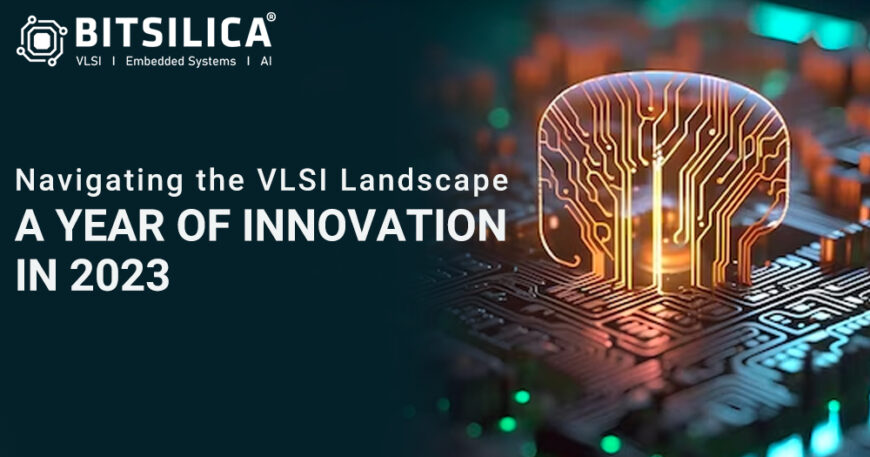Navigating the VLSI Landscape: A Year of Innovation in 2023
Introduction
As we bid farewell to 2023, it’s essential to reflect on the transformative trends that have defined the Very-Large-Scale Integration (VLSI) landscape. This year witnessed remarkable advancements across various domains, propelling the field into new dimensions. Let’s delve into the key trends that shaped VLSI innovation in 2023.
AI-Driven VLSI Design- Revolutionizing Efficiency in the AI Chip Market
The integration of Artificial Intelligence (AI) with VLSI design marked a paradigm shift, particularly in the AI chip market. AI-optimized chips, notably Graphics Processing Units(GPUs), played a pivotal role in enhancing computing efficiency. This revolution contributed to breakthroughs in deep learning and neural networks, opening new horizons for the field.
Neuromorphic Computing
Inspired by the intricate architecture of the human brain, neuromorphic computing emerged as a groundbreaking trend in VLSI. The development of neuromorphic sensors facilitated advanced sensing, enabling devices to perceive and process information akin to human cognition. This not only enhances artificial intelligence capabilities but also brings a more natural and intuitive dimension to computing.
Quantum Computing
Quantum computing continued to dominate VLSI research, showcasing its potential for unparalleled computational power. While not yet mainstream, ongoing developments in quantum processors and quantum bits (qubits) promised to revolutionize computing. This holds the key to addressing complex problems that are currently beyond the capabilities of classical computers, hinting at a transformative future for the field.
3D ICs: Scaling New Heights of Performance
As Moore’s Law faced challenges, 3D Integrated Circuits (ICs) emerged as a powerful solution to overcome traditional limitations. By stacking multiple layers of silicon, 3D ICs achieved higher transistor density and improved performance, pushing the boundaries of semiconductor technology. This trend represents a significant leap forward in sustaining the pace of technological advancements.
In-Memory Computing
In-memory computing reshaped data processing dynamics by integrating memory and computation. This approach accelerated data access, leading to faster and more efficient computing solutions, particularly in artificial intelligence and big data analytics applications. The synergy between memory and computation heralded a new era in data processing efficiency.
Silicon Photonics Co-Packaged Optics (CPO)
Silicon photonics emerged as a key player in data communication, with Co-Packaged Optics(CPO) leveraging its capabilities. This technology enhanced data transfer speeds and reduced latency, meeting the increasing demand for high-performance and low-power consumption in data centers. The transformative impact of silicon photonics on data communication signifies a crucial milestone in the evolution of VLSI.
IoT and Edge Computing in VLSI
The fusion of Internet of Things (IoT) and Edge Computing triggered a paradigm shift in VLSI.The demand for energy-efficient, compact designs capable of processing data at the edge influenced the development of VLSI solutions tailored for IoT applications. This trend not only expanded the connectivity landscape but also laid the foundation for a more decentralized and efficient computing architecture.
Advanced Memory Technologies
Advanced memory technologies, including Magneto resistive Random-Access Memory (MRAM), Phase Change Memory (PCM), and Resistive RAM (ReRAM), emerged as game-changers in the memory solutions domain. These innovations offered improved performance, durability, and energy efficiency compared to traditional memory technologies, addressing the growing need for faster and more reliable data storage.
Chiplets- Modular Marvels Redefining Semiconductor Integration
Chiplets gained momentum as a modular approach to semiconductor design. Breaking down complex systems into smaller, specialized components allowed for more efficient development, easier integration, and the flexibility to mix and match chipsets for diverse applications. This modular approach not only streamlined the design process but also paved the way for more customizable and adaptable semiconductor solutions.
Biodegradable Electronics and Wearable Electronics
The rising tide of environmentally conscious electronics was evident with the development of biodegradable electronics. Simultaneously, wearable electronics witnessed increased integration, providing seamless connectivity and data processing in compact, user-friendly form factors. These trends underscore the industry’s commitment to sustainability and user-centric design, ushering in a new era of responsible technology.
Conclusion
As we close the chapter on another year, the VLSI landscape stands transformed by a tapestry of innovations. From AI-driven design to quantum computing and sustainable electronics, each trend has left an indelible mark on the field. The collaborative spirit and ingenuity that fueled these advancements promise another year of pushing the boundaries of VLSI innovation. Let’s raise a toast to the journey ahead, where technology continues to evolve, shaping a future that is both exciting and full of possibilities.
KeyWords: VLSI, AI Chip Market, neuromorphic, Quantum Computing, 3D ICs, Silicon Photonics, ReRAM, Chiplets





